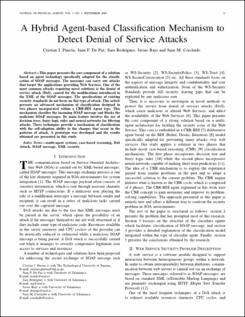Mostrar el registro sencillo del ítem
A hybrid agent-based classification mechanism to detect denial of service attacks
| dc.contributor.author | Pinzón Trejos, Cristian | |
| dc.contributor.author | De Paz, Juan | |
| dc.contributor.author | Rodríguez, Sara | |
| dc.contributor.author | Bajo, Javier | |
| dc.contributor.author | Corchado, Juan | |
| dc.date.accessioned | 2018-06-05T19:53:40Z | |
| dc.date.available | 2018-06-05T19:53:40Z | |
| dc.date.issued | 09/03/2009 | |
| dc.date.issued | 09/03/2009 | |
| dc.identifier.issn | 1888-0258 | |
| dc.identifier.uri | http://ridda2.utp.ac.pa/handle/123456789/4786 | |
| dc.description | This paper presents the core component of a solution based on agent technology specifically adapted for the classification of SOAP messages. The messages can carry out attacks that target the applications providing Web Services. One of the most common attacks requiring novel solutions is the denial of service attack (DoS), caused for the modifications introduced in the XML of the SOAP messages. The specifications of existing security standards do not focus on this type of attack. This article presents an advanced mechanism of classification designed in two phases incorporated within a CBR-BDI Agent type. This mechanism classifies the incoming SOAP message and blocks the malicious SOAP messages. Its main feature involves the use of decision trees, fuzzy logic rules and neural networks for filtering attacks. These techniques provide a mechanism of classification with the self-adaption ability to the changes that occur in the patterns of attack. A prototype was developed and the results obtained are presented in this study. | en_US |
| dc.description.abstract | This paper presents the core component of a solution based on agent technology specifically adapted for the classification of SOAP messages. The messages can carry out attacks that target the applications providing Web Services. One of the most common attacks requiring novel solutions is the denial of service attack (DoS), caused for the modifications introduced in the XML of the SOAP messages. The specifications of existing security standards do not focus on this type of attack. This article presents an advanced mechanism of classification designed in two phases incorporated within a CBR-BDI Agent type. This mechanism classifies the incoming SOAP message and blocks the malicious SOAP messages. Its main feature involves the use of decision trees, fuzzy logic rules and neural networks for filtering attacks. These techniques provide a mechanism of classification with the self-adaption ability to the changes that occur in the patterns of attack. A prototype was developed and the results obtained are presented in this study. | en_US |
| dc.format | application/pdf | |
| dc.language | eng | |
| dc.language.iso | eng | en_US |
| dc.rights | info:eu-repo/semantics/restrictedAccess | |
| dc.subject | multi-agent systems | en_US |
| dc.subject | case-based reasoning | en_US |
| dc.subject | DoS Attack | en_US |
| dc.subject | SOAP message | en_US |
| dc.subject | XML security | en_US |
| dc.subject | multi-agent systems | |
| dc.subject | case-based reasoning | |
| dc.subject | DoS Attack | |
| dc.subject | SOAP message | |
| dc.subject | XML security | |
| dc.title | A hybrid agent-based classification mechanism to detect denial of service attacks | en_US |
| dc.type | info:eu-repo/semantics/article | |
| dc.type | info:eu-repo/semantics/publishedVersion |
